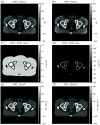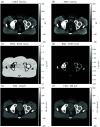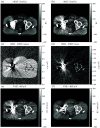Dual-energy computed tomography imaging with megavoltage and kilovoltage X-ray spectra
- PMID: 38445223
- PMCID: PMC10910563
- DOI: 10.1117/1.JMI.11.2.023501
Dual-energy computed tomography imaging with megavoltage and kilovoltage X-ray spectra
Abstract
Purpose: Single-energy computed tomography (CT) often suffers from poor contrast yet remains critical for effective radiotherapy treatment. Modern therapy systems are often equipped with both megavoltage (MV) and kilovoltage (kV) X-ray sources and thus already possess hardware for dual-energy (DE) CT. There is unexplored potential for enhanced image contrast using MV-kV DE-CT in radiotherapy contexts.
Approach: A single-line integral toy model was designed for computing basis material signal-to-noise ratio (SNR) using estimation theory. Five dose-matched spectra (3 kV, 2 MV) and three variables were considered: spectral combination, spectral dose allocation, and object material composition. The single-line model was extended to a simulated CT acquisition of an anthropomorphic phantom with and without a metal implant. Basis material sinograms were computed and synthesized into virtual monoenergetic images (VMIs). MV-kV and kV-kV VMIs were compared with single-energy images.
Results: The 80 kV-140 kV pair typically yielded the best SNRs, but for bone thicknesses , the detunedMV-80 kV pair surpassed it. Peak MV-kV SNR was achieved with dose allocated to the MV spectrum. In CT simulations of the pelvis with a steel implant, MV-kV VMIs yielded a higher contrast-to-noise ratio (CNR) than single-energy CT and kV-kV DE-CT. Without steel, the MV-kV VMIs produced higher contrast but lower CNR than single-energy CT.
Conclusions: This work analyzes MV-kV DE-CT imaging and assesses its potential advantages. The technique may be used for metal artifact correction and generation of VMIs with higher native contrast than single-energy CT. Improved denoising is generally necessary for greater CNR without metal.
Keywords: basis material decomposition; computed tomography; dual-energy; estimation theory; megavoltage imaging; simulation.
© 2024 The Authors.
Figures



















Similar articles
-
Utility of photon-counting detectors for MV-kV dual-energy computed tomography imaging.J Med Imaging (Bellingham). 2024 Dec;11(Suppl 1):S12811. doi: 10.1117/1.JMI.11.S1.S12811. Epub 2024 Dec 26. J Med Imaging (Bellingham). 2024. PMID: 39735347
-
Generation of hybrid sinograms for the recovery of kV-CT images with metal artifacts for helical tomotherapy.Med Phys. 2015 Aug;42(8):4654-67. doi: 10.1118/1.4926552. Med Phys. 2015. PMID: 26233193
-
Technical performance of a dual-energy CT system with a novel deep-learning based reconstruction process: Evaluation using an abdomen protocol.Med Phys. 2023 Mar;50(3):1378-1389. doi: 10.1002/mp.16151. Epub 2022 Dec 29. Med Phys. 2023. PMID: 36502496
-
Assessment of an advanced image-based technique to calculate virtual monoenergetic computed tomographic images from a dual-energy examination to improve contrast-to-noise ratio in examinations using iodinated contrast media.Invest Radiol. 2014 Sep;49(9):586-92. doi: 10.1097/RLI.0000000000000060. Invest Radiol. 2014. PMID: 24710203
-
Metal artifact correction for x-ray computed tomography using kV and selective MV imaging.Med Phys. 2014 Dec;41(12):121910. doi: 10.1118/1.4901551. Med Phys. 2014. PMID: 25471970 Free PMC article.
Cited by
-
Utility of photon-counting detectors for MV-kV dual-energy computed tomography imaging.J Med Imaging (Bellingham). 2024 Dec;11(Suppl 1):S12811. doi: 10.1117/1.JMI.11.S1.S12811. Epub 2024 Dec 26. J Med Imaging (Bellingham). 2024. PMID: 39735347
References
LinkOut - more resources
Full Text Sources

